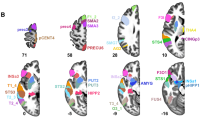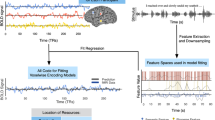Abstract
We have implemented neurosemantic analysis to identify voxel-wise representations of lexical items in brain’s reaction of native participants on Russian spoken narratives and these representations possible global asymmetries in the brain. Twenty-five subjects took part in this study. Five texts with personal life stories were presented as audio stimuli. Each story was 2 min long. Ultrafast MRI sequences (TR = 1000 ms) were used to scan brain activity. Scanning was performed on 3 T MRI (Siemens). Seven subjects were selected for further analysis following the control of their cognitive involvement into listening and the level of their registered brain activity. As in an earlier our study with these narratives, twelve lexical clusters were found, with different but coherent semantic fields: from time-and-space concepts to human actions and mental states. The individual semantic maps of each subject look similar in terms of their broad brain activity distribution. Clusters demonstrated nearly symmetrical localization. This fact implies that the left and right hemispheres are both involved in the neural representation of mental lexicon.
Access this chapter
Tax calculation will be finalised at checkout
Purchases are for personal use only
Similar content being viewed by others
References
Ardila, A.: A proposed neurological interpretation of language evolution. Behav. Neurol. 2015, 872487 (2015). https://doi.org/10.1155/2015/872487
Luria, A.R.: Language and brain: towards the basic problems of neurolinguistics. Brain Lang. 1, 1–14 (1974). https://doi.org/10.1016/0093-934X(74)90022-4
Luria, A.R.: Basic Problems in Neurolinguistics. Mouton, The Hague (1976)
Grabowski, T.J., Damasio, H., Tranel, D., Ponto, L.L.B., Hichwa, R.D., Damasio, A.R.: A role for left temporal pole in the retrieval of words for unique entities. Hum. Brain. Mapp. 13, 199–212 (2001). https://doi.org/10.1002/hbm.1033
Damasio, H., Tranel, D., Grabowski, T., Adolphs, R., Damasio, A.: Neural systems behind word and concept retrieval. Cognition 92, 179–229 (2004). https://doi.org/10.1016/j.cognition.2002.07.001
Binder, J.R., Desai, R.H., Graves, W.W., Conant, L.L.: Where is the semantic system? A critical review and meta-analysis of 120 functional neuroimaging studies. Cereb. Cortex 19, 2767–2796 (2009). https://doi.org/10.1093/cercor/bhp055
Assaf, M., Calhoun, V.D., Kuzu, C.H., Kraut, M.A., Rivkin, P.R., Hart, J., Pearlson, G.D.: Neural correlates of the object-recall process in semantic memory. Psychiatry Res. Neuroimaging 147, 115–126 (2006). https://doi.org/10.1016/j.pscychresns.2006.01.002
Huth, A.G., de Heer, W.A., Griffiths, T.L., Theunissen, F.E., Gallant, J.L.: Natural speech reveals the semantic maps that tile human cerebral cortex. Nature 532, 453–458 (2016). https://doi.org/10.1038/nature17637
Caramazza, A., Shelton, J.R.: Domain-specific knowledge systems in the brain the animate-inanimate distinction. J. Cogn. Neurosci. 10, 1–34 (1998). https://doi.org/10.1162/089892998563752
Mummery, C.J., Patterson, K., Hodges, J.R., Price, C.J.: Functional neuroanatomy of the semantic system: divisible by what? J. Cogn. Neurosci. 10, 766–777 (1998). https://doi.org/10.1162/089892998563059
Velichkovsky, B.M., Zaidelman, L.Y., Kotov, A.A., Nosovets, Z.A., Ushakov, V.L., Zabotkina, V.I.: The nature of neurosemantic representation: Stimuli, meaning, and personal sense. Quest. Psychol. (Boпpocы пcиxoлo гии) 66(3), 132–146 (2020). (in Russian)
Velichkovsky, B.M., Zabotkina, V.I., Nosovets, Z.A., Kotov, A.A., Zaidelman, L.Y., Nosovets, Z.A., Kartashov, S.I., Korosteleva, A.N., Malakhov, D.G., Orlov, V.A., Zinina, A.A., Goldberg, E., Ushakov, V.L.: Towards semantic brain mapping methodology based on a multidimensional markup of continuous Russian-language texts. STM 12(2), 14–25 (2020). https://doi.org/10.17691/stm2020.12.2.02
Zaidelman, L.Y., Nosovets, Z.A., Kotov, A.A., Ushakov, V.L., Zabotkina, V.I., Velichkovsky, B.M.: Russian-language neurosemantics: clusterizing of words meaning and sense from the oral narratives. Cogn. Syst. Res. 67, 60–65 (2021)
Velichkovsky, B.M., Kotov, A.A., Zabotkina, V.I., Nosovets, Z.A., Goldberg, E., Zaidelman, L.Y.: Heteroglossia in Neurosemantics: The Case of a Word Cluster with Mentalist Content. In: Velichkovsky, B., et al. (eds.) Advances in Cognitive Research, Artificial Intelligence and Neuroinformatics. Advances in Intelligent Systems and Computing, vol. 1358, pp. 307–318 (2021)
Kutuzov A., Kuzmenko E.: WebVectors: a toolkit for building web interfaces for semantic vector models. In: Ignatov, D., et al. (ed.) AIST 2016. CCIS, vol. 661, pp. 155–161. Springer, Cham (2017). https://doi.org/10.1007/978-3-319-52920-2
Lyashevskaya, O.N., Sharov S.A.: Frequency Dictionary of the Modern Russian Language (The Russian National Corpus). Azbukovnik (2009)
SPM8 Software. https://www.fil.ion.ucl.ac.uk/spm/software/spm8
Tzourio-Mazoyer, N., Landeau, B., Papathanassiou, D., Crivello, F., Etard, O., Delcroix, N., Mazoyer, B., Joliot, M.: Automated anatomical labeling of activations in SPM using a macroscopic anatomical parcellation of the MNI MRI single-subject brain. Neuroimage 15, 273–289 (2002). https://doi.org/10.1006/nimg.2001.0978
Price, C.J.: The anatomy of language: a review of 100 fMRI studies published in 2009. Ann. N.Y. Acad. Sci. 1191, 62–88 (2010). https://doi.org/10.1111/j.1749-6632.2010.05444.x
Price, C.J.: A review and synthesis of the first 20 years of PET and fMRI studies of heard speech, spoken language and reading. Neuroimage 62, 816–847 (2012). https://doi.org/10.1016/j.neuroimage.2012.04.062
Mariën, P., Engelborghs, S., Fabbro, F., De Deyn, P.P.: The lateralized linguistic cerebellum: a review and a new hypothesis. Brain Lang. 79, 580–600 (2001). https://doi.org/10.1006/brln.2001.2569
Argyropoulos, G.P.D.: The cerebellum, internal models and prediction in ‘non-motor’ aspects of language: a critical review. Brain Lang. 161, 4–17 (2016). https://doi.org/10.1016/j.bandl.2015.08.003
van den Hurka, J., Baelena, M.V., de Beecka, H.P.O.: Development of visual category selectivity in ventral visual cortex does not require visual experience. PNAS 114, 4501–4510 (2017). https://doi.org/10.1073/pnas.1612862114
Jackendoff, R.: Meaning and the Lexicon. Oxford University Press, Oxford, UK (2010)
Jackendoff, R.. : Defence of theory. Cogn. Sci. 41(2), 185–212 (2017). https://doi.org/10.1111/cogs.12324
Tononi, G., Boly, M., Massimini, M., Koch, C.: Integrated information theory: from consciousness to its physical substrate. Nat. Rev. Neurosci. 17, 450–461 (2016). https://doi.org/10.1038/nrn.2016.44
Dehghani, M., Boghrati, R., Man, K., Hoover, J., Gimbel, S., Vaswani, A., Zevin, J., Immordino-Yang, M., Gordon, A., Damasio, A., Kaplan, J.: Decoding the neural representation of story meanings across languages. Hum. Brain. Mapp. 38, 6096–6106 (2017). https://doi.org/10.1002/hbm.23814
Acknowledgements
The study has been in part supported by the Russian Science Foundation, grant 17-78-30029.
Author information
Authors and Affiliations
Corresponding author
Editor information
Editors and Affiliations
Appendix
Appendix
Rights and permissions
Copyright information
© 2021 The Author(s), under exclusive license to Springer Nature Switzerland AG
About this paper
Cite this paper
Nosovets, Z. et al. (2021). Voxel-Wise Localization of Brain Activity While Comprehending Oral Russian-Language Stories. In: Velichkovsky, B.M., Balaban, P.M., Ushakov, V.L. (eds) Advances in Cognitive Research, Artificial Intelligence and Neuroinformatics. Intercognsci 2020. Advances in Intelligent Systems and Computing, vol 1358. Springer, Cham. https://doi.org/10.1007/978-3-030-71637-0_35
Download citation
DOI: https://doi.org/10.1007/978-3-030-71637-0_35
Published:
Publisher Name: Springer, Cham
Print ISBN: 978-3-030-71636-3
Online ISBN: 978-3-030-71637-0
eBook Packages: Intelligent Technologies and RoboticsIntelligent Technologies and Robotics (R0)




